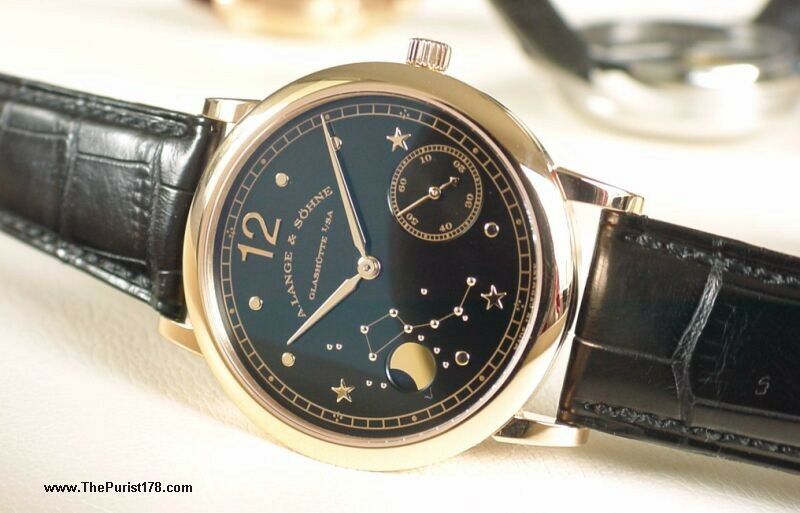
Marcus Hanke
[PuristSPro Moderator]
11515

Ticket to the Moon: Ulysse Nardin's "Moonstruck", Part I
A Ticket to the Moon
Ulysse Nardin's "Moonstruck"
Part I:
The quest for astronomical accuracy
by Marcus Hanke
(c) text and pictures, if not noted otherwise, Marcus Hanke and PuristSPro, October 2009
Ulysse Nardin's "Moonstruck"
Part I:
The quest for astronomical accuracy
by Marcus Hanke
(c) text and pictures, if not noted otherwise, Marcus Hanke and PuristSPro, October 2009
Many years ago, Ludwig Oechslin explained to me his concept behind the magnificent astronomical "Trilogy in Time": "It is like a journey through space: You start approaching the solar system and see the planets circling around the Sun. This is what I have shown on the "Planetarium". Then you close in on Earth, you notice it partially illuminated by the Sun, like I did on the "Tellurium". Finally, after landing on Earth's surface, you turn around and look back into the sky, where you have come from. You see the stars moving over the endless dome stretching above you. This view I have reproduced on the "Astrolabium"."

Trilogy set, (c) Ulysse Nardin
Released between 1985 and 1992, the "Trilogy" guaranteed Ulysse Nardin immediate fame and acknowledgement as innovative brand able to produce unique and highly complicated watches. For Ludwig Oechslin, as it seemed, the time of astronomical timepieces and their philosophical implications was over, and an era of practical complications, like that of a perpetual calendar adjustable forward and backward, a most easy to use GMT mechanism, a 24 hours alarm function with countdown, or of new escapements began.

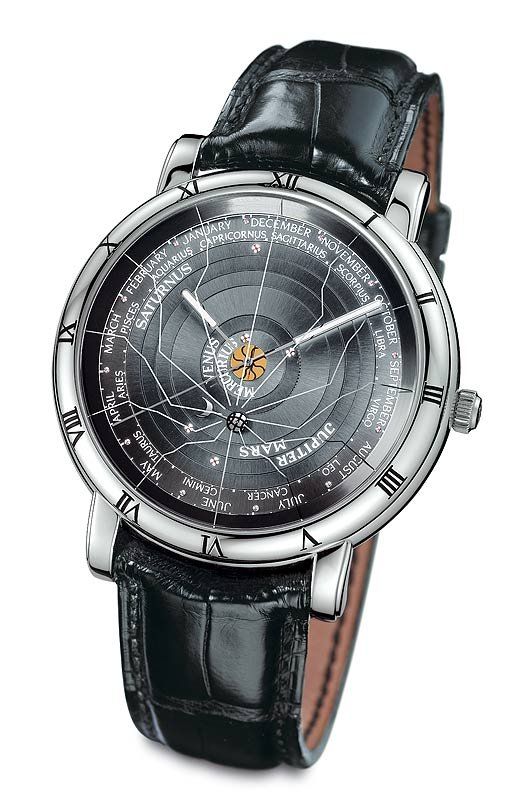

Astrolabium, Planetarium and Tellurium, (c) Ulysse Nardin
However, even after the "Trilogy" was completed, Oechslin did not stop thinking about astronomy: In 1993, he developed and patented a three-dimensional moon phase indication for Bunz. The unique "Moontime I" featured a rotating moon sphere circling the dial in 29.5312 days. Only two years later, the magnificent Türler clock was unveiled in Zurich, with Ludwig Oechslin being the mastermind behind it.

Bunz "Moontime I", (c) Bunz Montres

The Türler clock, on display in Zurich, (c) Türler
Five years ago, I posted a picture that I had found in the Swiss patent database:
ulyssenardin.watchprosite.com
In 2003, Ulysse Nardin and Ludwig Oechslin had filed the patent for another astronomical indication on a mechanical wristwatch, and we were thrilled to see if this concept would be realised in an actual watch. Finally, after many years of technical development and research, Ulysse Nardin ends this time of waiting, releasing the marvellous "Moonstruck".
While all three pieces of the "Trilogy of Time" showed the correct moon phase in various ways (central lunar hand on Astrolabium, small crescent on Planetarium, moon disk rotating around the Earth on Tellurium), the Moon always was but one element among others, and not in the focus of attention. Additionally, the Moon's influence on Earth was considered only regarding its shadow, when causing an eclipse.
The new patent, that lead to the "Moonstruck", clearly showed a concentration on the Moon and its other, even more important influence on Earth, the tides.
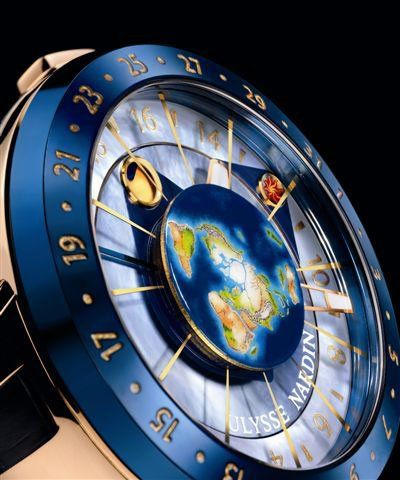
(c) Ulysse Nardin
Reading the patent declaration, though, there is one issue mentioned several times: the very high accuracy of the new moon phase display. This seemed to be especially interesting: Why should accuracy be important in a moon phase indication? So I decided to start my small series on the "Moonstruck" with the issue of moon phase accuracy:
The phases of the Moon
Along with this virtual movement across the night sky, we are also aware of the repeating changes in the illuminated area of the Moon. These lunar phases are the result of the changing angle between the Moon rotating around the Earth, and the Sun from which it receives its light.

On its path, when the Moon has a position between the Sun and the Earth, we only see its shadowed side, which of course results in seeing nothing of the Moon at all. This phase is the "new moon". After orbiting to the opposite side of the Earth, the Moon is fully back-lit by the Sun when observed from the Earth - this is "full moon". Between these two phases, the Moon waxes until one half is illuminated (referred to as the first quarter) and wanes with the other half illuminated (referred to as the third quarter).
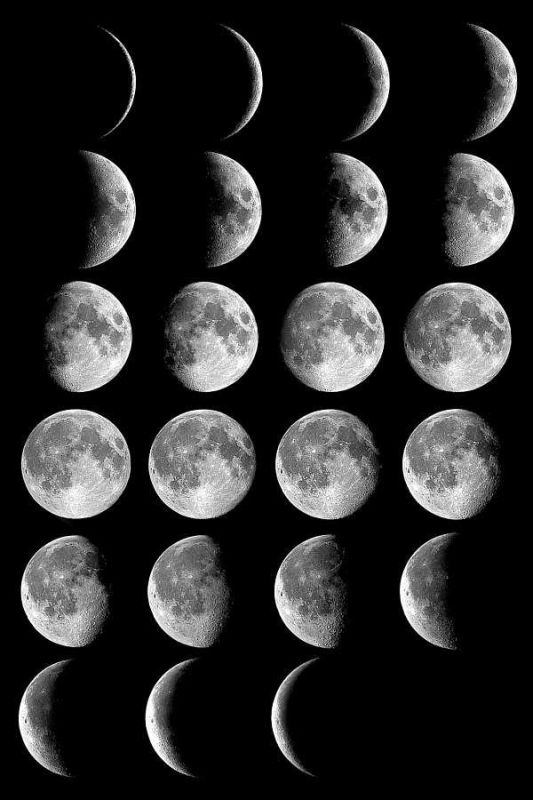
(c) NASA
The period between two of the same phases is 29 days, 12 hours, 44 minutes and 2.9 seconds, which is also called the "synodic month". However, this is not identical with the true rotation period of the Moon around the Earth:
To complete a 360 degree circle around the Earth, the Moon only needs 27 days, 7 hours, 43 minutes and 11.5 seconds (sidereal month). During this time, though, the whole Earth–Moon system itself has moved on its path around the Sun, and the angle of illumination has changed too. As a consequence, the Moon has to continue a bit even after the 360 degree-mark, to get the same illumination as it had in its starting point, as seen from Earth.

But what about the accuracy issue?
As we all know, any mechanical system depends on the transmission of energy and movement, accomplished by pins, levers, and mostly teethed wheels. The rotation speed of teethed wheels is determined by the number of their teeth, which means that any wheel needs an impulse to be advanced by one tooth. One full rotation takes as many impulses as there are teeth.
For a moon phase display, it would be the easiest realisation to use a teethed wheel advancing once a day. This can be done as a by-product of the calendar mechanism, that advances the date once every day, normally around midnight. However, as we learnt above, the synodic month, the period between two identical phases of the Moon, lasts 29 days, 12 hours, 44 minutes and 2.9 seconds, or 29.5305891 days. Since it is impossible to advance a teethed wheel by a half step, and there is no half tooth, the watch manufacturer has a problem. Of course he could simply round up to 30 and forget nearly half a day. Such a moon phase display would work, but barely be more than a purely decorative element: After only two months, it would be a day off, compared with the actual moon outside the window, and after a year, it would show the first quarter, instead of the new moon.
However, it is possible to reduce the error, by doubling the number of phase cycles that should be shown by the wheel: If the watch manufacturer takes one wheel with 59 teeth, this indicates two synodic months of 29.5 days each.

Every day, the wheel is advanced by one tooth, completing one turn every two moon phase cycles. Normally, it rotates behind a dial cutout, shaped to show the Moon as a crescent, waxing until the full disk is in the centre of the cutout, and starting to wane, until the completely dark blue window content indicates the new moon.
This kind of moon phase display has proven very popular, and is the industry standard still today. Its major disadvantage is the lack of accuracy, since due to the necessary rounding, every cycle is 44 minutes too short. Within three years, this adds to a deviation of one day. Compared with the above mentioned example of only one cycle on the wheel and a day's deviation already every two months, most watch manufacturers consider the former acceptable. Since mechanical watches are readjusted in much shorter intervals, the users are likely to correct the moon phase by a day every three years without complaint.

Conventional moon phase display
Astronomical moon phase displays
However, for an astronomical timepiece, this is not enough, and this is the point where the problem starts: The perfect wheel for a moon phase display would need so many teeth that fractions of teeth are unnecessary. If we look at the duration of one lunar phase, 29.5305891 days, the difficulty would be the production of a wheel with no less than 295,305,891 teeth! To advance it, the watch's hour wheel would need to drive an intermediary wheel with 1,000,000 teeth, so as a result, the moon phase wheel would make one complete rotation every 29.5305891 days. I think it is clear that such wheels would have giant dimensions, and even today's oversized wristwatches would have to grow considerably, into the ten meters-category, to accommodate them.
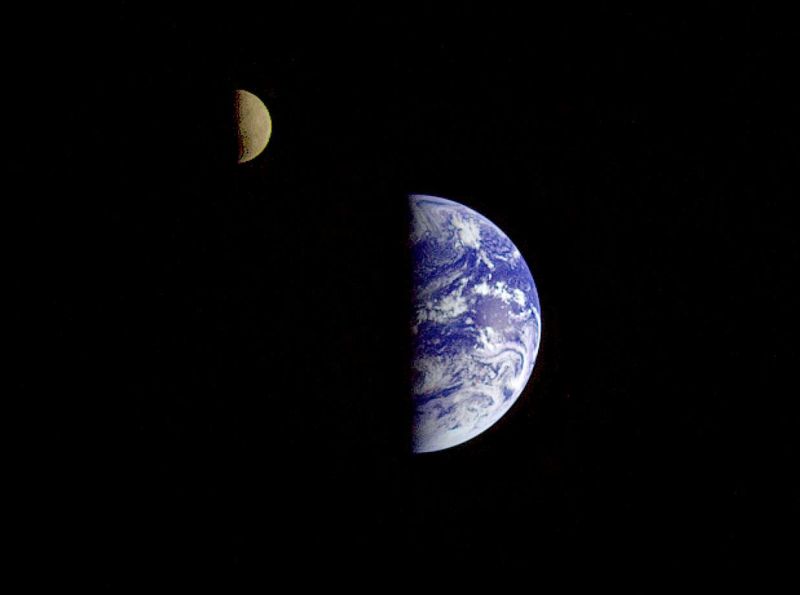
(c) NASA
We thus realise that a completely accurate moon phase display is extremely difficult to accomplish. The task is to reach an acceptable accuracy by reasonably rounding the duration of one cycle. When rounding the synodic month to 29.53, a rather tolerable accuracy of a deviation of one day per 80.9 years could be reached. But this would necessitate a wheel with 2,953 teeth, which is no option either.
Fortunately, mechanics permit accomplishing various rotation speeds by combining several teethed wheels. If the number of teeth is cleverly calculated, the transmission ratio results in the desired rotation period. Without going into details, a combination of two wheels and two cogs has become standard for "better" moon phase displays, reaching an accuracy of one day deviation about every 120 to 125 years. Most current high-class timepieces emphasising the moon phase are following this path: Arnold & Son's "True Moon", and Piaget's "Emperador Moonphase", to mention but two recent examples.
Is it acceptable for watch owners to correct their moon phase displays every 120 years? Or better: letting their heirs know about this important task? I think it is more than acceptable, especially, since barely any depiction of the moon phase on wrist watches is large or detailed enough to let anybody realise this deviation. Until somebody will notice anything, at least 240 years have to pass; and, let's be honest, our sense for responsibility for future generations ceases to be relevant somewhen after 150 years ...
However, despite every reason, the accuracy of moon phase displays in mechanical timepieces became a marketing argument: It started with the release of the IWC "da Vinci" perpetual calendar in 1985, with an advertised moon phase accuracy of 122 years per one day deviation. The gears realised a synodic month of 29.53125 days. IWC had another reason for pursuing this accuracy, though: Its perpetual calendar was fully programmed, firmly connecting the moon phase with all other calendar indications. Since it is not possible to correct the former independently from the latter, it was necessary to develop an indication that would not necessitate visiting the master watchmaker before the year 2100, when the omission of a leap year finally forces the owner to have the mechanism readjusted.
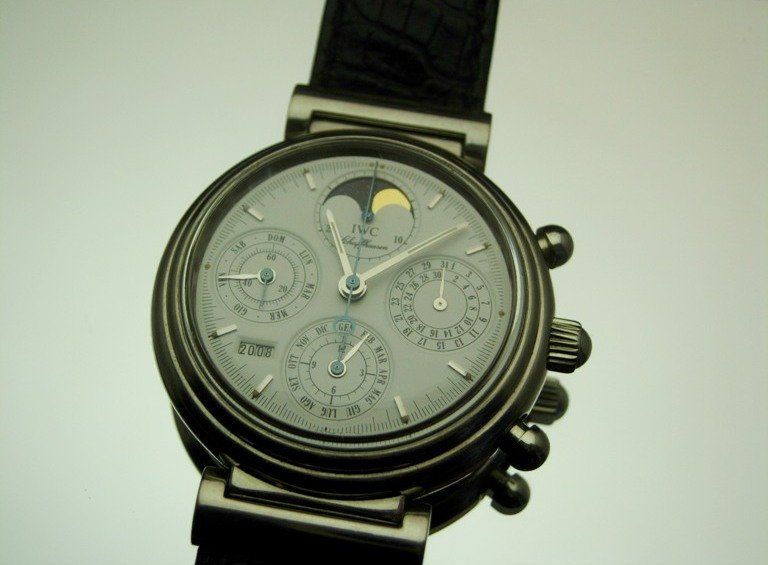
IWC "da Vinci", 1985 - reproduced with kind permission by Quadrilette172, forum.watchtime.ch
Many years later, the larger C.5161 Portugieser movement permitted the IWC engineers to use larger wheels with more teeth, resulting in a better moon phase accuracy of 561 years per one day deviation from the actual moon phase.
Finally, the moon phase accuracy became the one and only marketing asset of Lange & Söhne's 1815 Moon phase, released in 1999. The moon, displayed in a circular cutout window on the dial, was claimed to be off by one day after 1,000 years. This was made possible by a gear that is not advancing the moon phase once a day, but once per hour. However, it was also admitted that this value was a purely theoretical one, the result of calculations based on the gear's transmission ratio. In reality, variations of the watch itself, service, times of inoperativeness, etc. would make sure that this theoretical value is never reached.
Ludwig Oechslin, Master of the Moon Phase
And what about Ulysse Nardin, what about Ludwig Oechslin, the academic genius behind the astronomical watches? I think it is important to state that the indication’s accuracy was never the main intention behind Oechslin’s development efforts. What he wanted to accomplish, was the presentation of astronomical dynamics and perspectives; improving the accuracy was a welcome byproduct of the former.
Besides so many other titles and attributes connected with Ludwig Oechslin, it would be completely justified to announce him the unrivalled “Master of the Moon Phase”: No other master watchmaker, not even the genius mechanics and masters of astronomical timepieces of the past, like Jost Bürgi and Philipp Matthäus Hahn, both often-quoted examples for Oechslin, have realised moon phase displays in so many different ways. Starting with the lunar depiction by a hand (Astrolabium and Oechslin-Spöring clock), followed by a crescent circling a small, off-centered Earth disk (Planetarium), then by a small lunar disk rotating around a large Earth depiction in the centre (Tellurium), a three-dimensional lunar sphere, rotating itself AND around the dial (Moontime I), the completely three-dimensional model in the Türler clock, the moon hand, combined with a spheroid projection of the Earth (Planet Earth), he made the “Moonstruck”, combining two moon phase indications into one, as latest display variant.
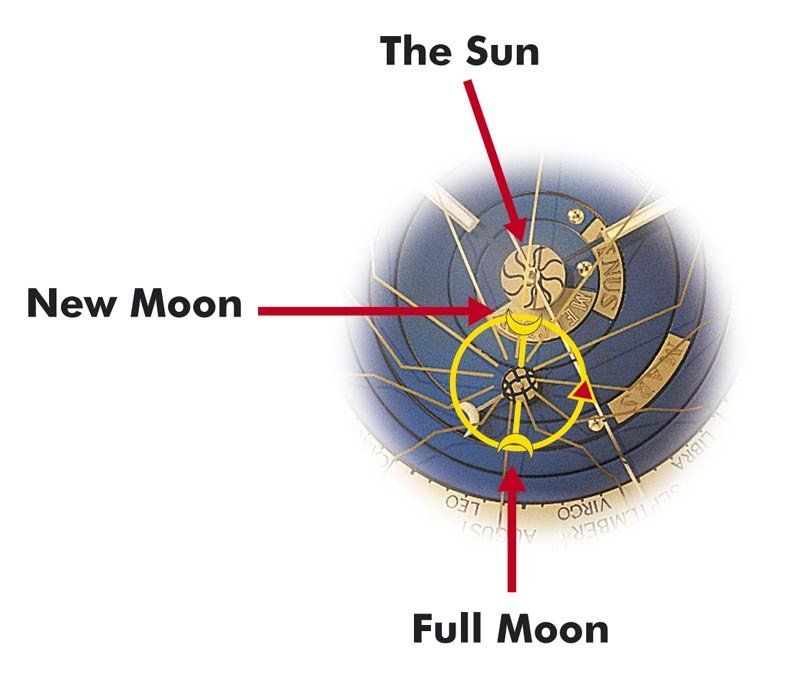
Planetarium Moon Phase

Tellurium Moon Phase

Türler Clock Moon Phase, (c) Türler

Planet Earth moon phase, (c) Ulysse Nardin
Aside all this richness of presentations, accuracy was of course always on Oechslin's mind, too. At last, his creations should fulfil the standards of an astronomical instrument. His moon phase indications, even when only a small detail in a much more complex astronomical display, were always highly accurate:
The small moon crescent on the "Planetarium" needs more than 74 years until it is one day off from the astronomical moon. The "Tellurium" was already extremely close to the actual moon, with a period of 623.17 years for a single day off. His "Moontime" concept developed for Bunz in 1993 was in the "120 years for one day"-class. And the "Moonstruck"? We have to keep in mind that the "Moonstruck" combines two different moon phase displays. The first is showing the Moon circling around the Earth globe, in relation to the position of the Sun, and the second shows the actual phase in the circular dial cutout. The window display can be off by a day after 858.6 years, while the rotating ring shows that deviation only after 1,090.67 years!!
The most accurate moon phase display ever
Can the "Moonstruck" now rightfully claim the title of the "most accurate moon phase ever built into a wristwatch", dethroning the Lange 1815? Since the Lange is claiming a 1,000 years for one day-period, I guess the "Moonstruck" could be called the actual king of moon phase accuracy.
But is this title worth anything, or more important even: is it based on objective criteria? First of all, the chase after accuracy records for astronomical indications is somewhat senseless, since these mechanisms are based on watch movements that can be - even when within the strict chronometer limits - off by several seconds per day. Additionally, wristwatches have to be serviced every now and then, and it lies in their nature as luxury products, that they will not be worn and operative every single day. As a consequence, they have to be reset from time to time, and then normally the moon phase display will be set to the correct value again.
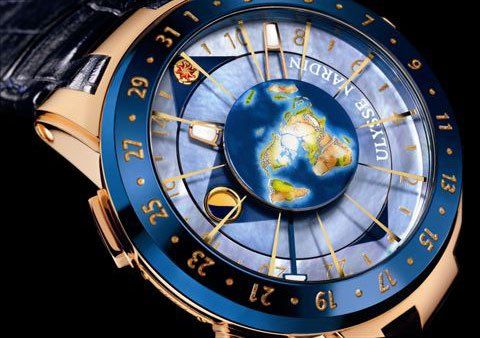
(c) Ulysse Nardin
Furthermore, the various marketing efforts resulting from the highly accurate moon phase displays, even even leading to the designation as "perpetual moon phase" by a prominent brand, normally do not disclose the mathematical base of the gear's calculations. As written above, it is barely possible to construct a gear that reproduces the synodic month of 29.5305891 days without rounding this figure. For most moon phase gears in the "120 years for one day off"-class, the period is rounded to 29,5306 days. The difference between the astronomical moon phase and this rounded value is tiny, not more than 0.0318 seconds per day, and therefore considered negligible.
However, astronomical moon phase displays can benefit massively from using the rounded value, regarding the "years for one day off"-ratio, that is so tempting for using it in the marketing. The "Moonstruck", for example, could thus gain nearly 200 years, if recalculated to the simpler figure! This example proves that the various claims for the accuracy of the moon phase are difficult to compare with each other, if the calculatory base is not disclosed. I should state, however, that Ulysse Nardin never emphasised the astronomical accuracy of its complications; these timepieces and their indications are speaking for themselves, and are a class of their own.
Of course it might be that a watch manufacturer will accept the "Moonstruck" as a challenge and develop a moon phase display that needs more than 1,090 years until it is a day off. Competition is always fine, and will stimulate the spirits and brains. Maybe this future competitor might appreciate another piece of information I am delighted to share: The "Astrolabium", presented by Ulysse Nardin in 1985, indicates the moon phase by the lunar hand. Its epicycloidal gear is the result of Oechslin's recreation of a mathematics discovered in the "Farnesian clock" from the early 18th century, and deviates from the astronomical moon phase by roughly a thousandth of a second per day. When its moon phase indication is one day off, only 220,770 years have passed.
Beat that.

Astrolabium: Abstract, but extremely acurate moon phase indication by solar and lunar hands

(c) NASA
Copyright October 2009 - Marcus Hanke & PuristSPro.com - all rights reserved
This message has been edited by Marcus Hanke on 2009-10-28 01:04:17
More posts:

Ticket to the Moon: Ulysse Nardin's "Moonstruck", Part I
A Ticket to the Moon Ulysse Nardin's "Moonstruck" Part I: The quest for astronomical accuracy by Marcus Hanke (c) text and pictures, if not noted otherwise, Marcus Hanke and PuristSPro, October 2009 (c) Ulysse Nardin Many years ago, Ludwig Oechslin explai...

Fantastic stuff...
I shall have to read it a second time to make sure I understood all of it. I hate to get all practical, but I do have one question about the watch, will it be easier to set than the trilogy pieces? A

Well, I think the Trilogy pieces do not deserve ....
... that bad reputation as being so difficult to set. For the perpetual, which is famed for its ease of use, I would always need the manual, since I forget the correct order of setting the indications. The Trilogy pieces are completely set by their crown,...

A good report, Marcus. Besides marketing ploys, there are...
problems with claiming high accuracies. I am not at home, but I know that the mean lunar synodic period has secular time varying terms. That is, the quoted number is accurate(to some error) at a specific epoch. Over thousand to hundreds of thousand of yea...

You are perfectly correct, Ronald ....
... and I should have made that clear in the article. I had thought about that complex of questions, but decided against including it in the article, since I thought it to be already confusing enough. It is clear that the medieval conception of the cosmos...

Seeing as periodic terms are usually not even considered, Almost everyone...
would not even think about them, much less the secular terms. I thought of having someone design a 3D Moon with the proper libration and shadowing, but I could not afford to have it made.

Too pity ...
... would have been a nice piece! However, even computer algorithms used in animations and software solutions are unable to include the unforeseeable: the laterations of the Earth axis tilt, the jumpy increase of the moon distance ... universe simply does...

I am certain it could be done at UN, but I believe the 3D Moon is not..
its style. You could ask them.

Post worth of outmost admiration
Islay definitely for this one Laphroaig is all I have at hand Will it do? So much to learn and so little time This one is keeper All the best Damian

The Astrolabium and Planetarium look good as does the
UN Scatola winder. More info then I can digest in one sitting. And you had to show th 1815 moonphase again.... Thanks for this informative post!

Bravo, Marcus!
This is a great post! I will need a couple more times reading the article before I can fully process everything I think, but my initial reading reveals a wonderfully educational and supremely interesting post! I'm not sure that my IQ qualifies me to under...

You are too kind, Daos! ....
Thanks a lot for your compliments, which, of course, I appreciate a lot I have to admit that I find it difficult very often to understand the world of watchmakers. Maybe you know these elements of popular IQ tests, wehre you see several teethed wheels, an...

BRAVO!
Your article does a great job of extending the discussion of displaying moon phases on a wrist-worn device. I will be happy when I can actually see and play with a Moonstruck, as it's not clear to me how the display really represents the changing moon and...

You have to wait for part three ....
... where I will analyse the Moonstruck functions in detail. I just wanted to keep you nervously waiting, so I didn't mention anything about it in the first article ... Regards, Marcus

Fantastic post Marcus !
One of the most interesting articles of the year ! Thanks ! Fr.Xavier

Thank you very much! ....
... but there are so many highly interesting posts published here, that I really have difficulties to keep track of them myself. Regards, Marcus


Thanks! Great information!
Before this, I had only known of the more basic moonphase transmission ratios that would allow for a 1 day deviation every 122 years. I didn't even know about Lange & Sohne's moonphase watch had a day deviation for every 1000 years. But I'm even further a...

Thanks! But already the "conventional" 120 years-moon phases ....
... require some effort, not only in production, but also in assembly. I would not consider them "lesser" than UN Moonstruck or the Lange. Regards, Marcus

Aarrrgh.....
Herr Prof Dr Hanke, Is it jet-lag or hypoglycaemia or my Tasmanian single malt whisky? I cannot understand all of your paper Part 1 and fear the worse for Parts 2 and 3....... But, thank you anyway! The good news is that the UN +/- GMT Perpetual is dummko...

Don't be too humble, my dear MTF ....
... since I know you are playing with far more complex topics every day . But thanks a lot for the compliments, and I hope the upcoming two parts are less mathematical. Best regards, Marcus



